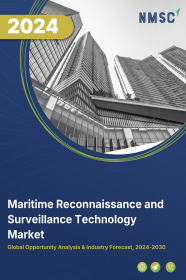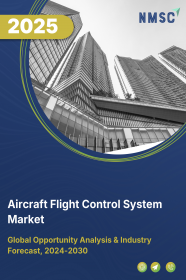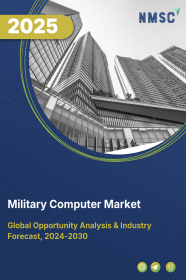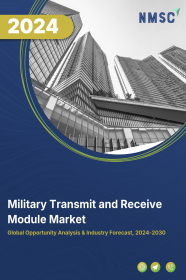
Maritime Reconnaissance and Surveillance Technology Market by Component (Hardware (Radar, Sensors, AIS Receiver, Camera, SONOBUOYS/Sonar, and Others), Software, Services (Manage Services/Maintenance, Integration and Implementation, Training and Consulting)), by Platform (Airborne (Unmanned Aerial Vehicle, Maritime Patrol Aircraft (MPA), and Aerostat), Surface Ships, Under Water Vehicle (Submarine and Underwater Drones)): Global Opportunity Analysis and Industry Forecast, 2020 – 2030
Industry: Aerospace & Defense | Publish Date: 05-Dec-2024 | No of Pages: 437 | No. of Tables: 250 | No. of Figures: 220 | Format: PDF | Report Code : AD376
US Tariff Impact on Maritime Reconnaissance and Surveillance Technology Market
Trump Tariffs Are Reshaping Global Business
Market Definition:
At an estimated value of over USD 29.46 billion in 2019, the Global Maritime Reconnaissance and Surveillance Technology Market is predicted to thrive at a CAGR of 5.5% and valued at over USD 48.93 billion over the forecast year 2020-2030. The maritime reconnaissance and surveillance technology is a feedback system which consists of deployment of surveillance assets. The information collected from these assets is compiled into a Recognized Maritime Picture (RMP). Hence, the reconnaissance and surveillance technologies have become the key to develop accurate and clear maritime situational awareness. The rapid technological advancements has led to the shift in the way maritime forces manage and utilize Intelligence, Surveillance and Reconnaissance (ISR) capabilities.
Market Dynamics and Trends:
Factors such as the increased prevalence of piracy & terrorism, maritime conflicts amongst the countries, and the presence of high-value commercial assets in oceans drive maritime reconnaissance and surveillance technology market. In addition to this, rise in international trade through sea along with the increased security concerns propels the growth of the market. However, significant decrease in military spending in several countries owing to the economic slowdown caused by COVID-19 pandemic hampers the market growth. On the other hand, growth in adoption of advanced patrol boats, Unmanned Aerial Vehicles (UAVs), and Maritime Patrol Aircraft (MPAs) to improve maritime security by numerous countries around the globe creates lucrative opportunities for the market growth.
Market Segmentations and Scope of the Study:
The global maritime reconnaissance and surveillance technology market share is segmented on the basis of component, platform, and geography. On the basis of component, the market is categorized into hardware (radar, sensors, AIS receiver, camera, SONOBUOYS/sonar, and others), software, and services (manage services/maintenance, integration and implementation, training and consulting). According to the platform, the market is divided into airborne (unmanned aerial vehicle, maritime patrol aircraft (MPA), and aerostat), surface ships, and under water vehicle (submarine and underwater drones. Geographic fragmentation and analysis of each segment includes regions comprising North America, Europe, Asia Pacific and RoW.
Geographical Analysis:
In terms of geography, North America held major share of the market in 2019. This is attributed to the increasing deployment of advanced maritime surveillance systems along with the high government spending on defense sector. In addition to this, Canada has the longest coastline of about 202,080 kilometers; hence, the maritime industry of Canada would exhibit huge demand for maritime reconnaissance and surveillance technology. However, Asia pacific is expected to witness highest growth rate as the sea-borne terrorism has emerged as one of the major security threats across littoral-Asia.
Competitive Landscape:
Lucrative growth opportunities make the maritime reconnaissance and surveillance technology market highly competitive. Some of the major players in the market are Boeing, Kongsberg Gruppen, SAAB, Thales SA, Raytheon Technologies, Indra Sistemas, Rheinmetall Air Defence, Kawasaki Heavy Industries, Ltd., Terma, and Elbit Systems and many more. A number of developmental strategies have been adopted by companies in the past few years. For instance, in February 2020, Boeing signed an agreement with Air Works, the Indian aviation service provider for the repair, maintenance, and overhaul (MRO) of Boeing’s key defense platforms in India. Under this agreement, Boeing initiated maintenance project for P-8I Aircraft, a multimission maritime patrol aircraft of Indian Navy.
Moreover, in October 2019, Raytheon Company collaborated with Korean Air to pursue the Intelligence Surveillance Target Acquisition and Reconnaissance program of Republic of Korea’s Air Force. Under the program, Raytheon is projected to be the prime contractor to provide multiple-intelligence, or Multi-INT technologies for the aircraft.
Key Benefits:
-
The maritime reconnaissance and surveillance technology market report provides the quantitative analysis of the current market and estimations through 2020-2030 that assists in identifying the prevailing market opportunities to capitalize on.
-
The study comprises an extensive analysis of the maritime reconnaissance and surveillance technology market trend including the current and future trends for depicting the prevalent investment pockets in the market
-
The information related to key drivers, restraints and opportunities and their impact on the maritime reconnaissance and surveillance technology market is provided in the report.
-
The market share of the players in the global maritime reconnaissance and surveillance technology market along with their competitive analysis.
-
Value chain analysis in the market study provides a clear picture of the stakeholders’ roles.
Key Market Segments:
By Component
-
Hardware
-
Radar
-
Sensors
-
AIS Receiver
-
Camera
-
SONOBUOYS/Sonar
-
Others
-
-
Software
-
Services
-
Manage Services/Maintenance
-
Integration and Implementation
-
Training and Consulting
-
By Platform
-
Airborne
-
Unmanned Aerial Vehicle
-
Maritime Patrol Aircraft (MPA)
-
Aerostat
-
-
Surface Ships
-
Under Water Vehicle
-
Submarine
-
Underwater Drones
-
By Geography
-
North America
-
U.S
-
Canada
-
Mexico
-
-
Europe
-
UK
-
Germany
-
France
-
Spain
-
Italy
-
Netherlands
-
Denmark
-
Finland
-
Norway
-
Sweden
-
Russia
-
Rest of Europe
-
-
Asia-Pacific
-
China
-
Japan
-
India
-
South Korea
-
Australia
-
Indonesia
-
Singapore
-
Taiwan
-
Thailand
-
Rest of Asia-Pacific
-
-
RoW
-
Latin America
-
Middle East
-
Africa
-
Key Players:
-
Boeing
-
Kongsberg Gruppen
-
SAAB
-
Thales SA
-
Raytheon Technologies
-
Indra Sistemas
-
Rheinmetall Air Defence
-
Kawasaki Heavy Industries, Ltd.
-
Terma
-
Elbit Systems
REPORT SCOPE AND SEGMENTATION:
|
Parameters |
Details |
|
Analysis Period |
2019–2030 |
|
Base Year Considered |
2020 |
|
Forecast Period |
2020–2030 |
|
Market Size Estimation |
Billion (USD) |
|
Market Segmentation |
By Component (Hardware, Software, Services) By Platform (Airborne, Surface Ships) |
|
Countries Covered |
28 |
|
Companies Profiled |
Boeing, Kongsberg Gruppen, SAAB, Thales SA, Raytheon Technologies, Indra Sistemas, Rheinmetall Air Defence, Kawasaki Heavy Industries, Ltd., Terma, and Elbit Systems |

















 Speak to Our Analyst
Speak to Our Analyst




















